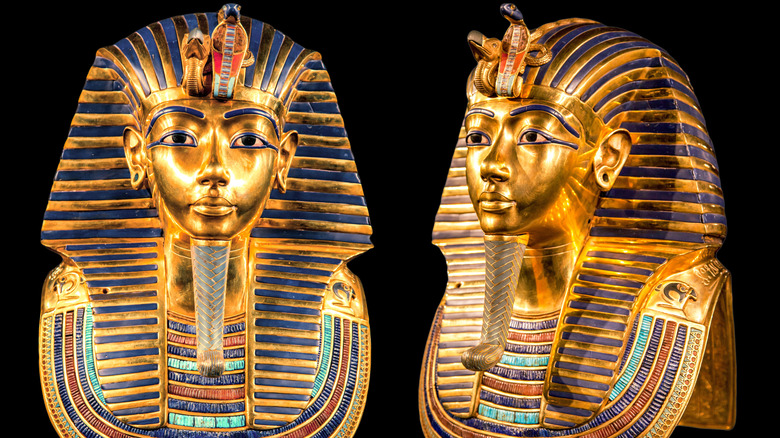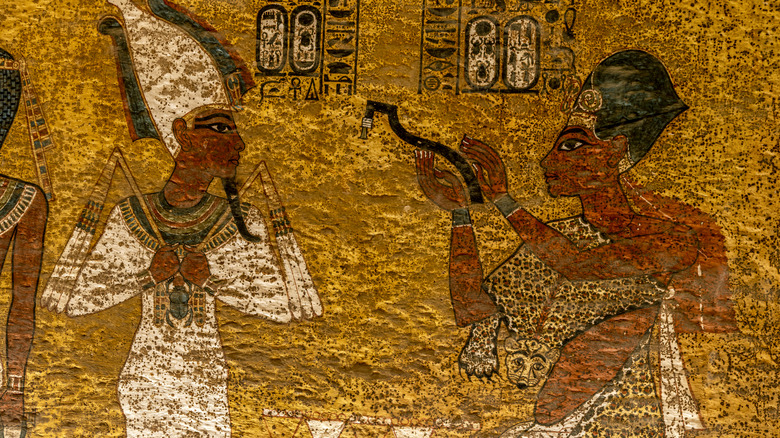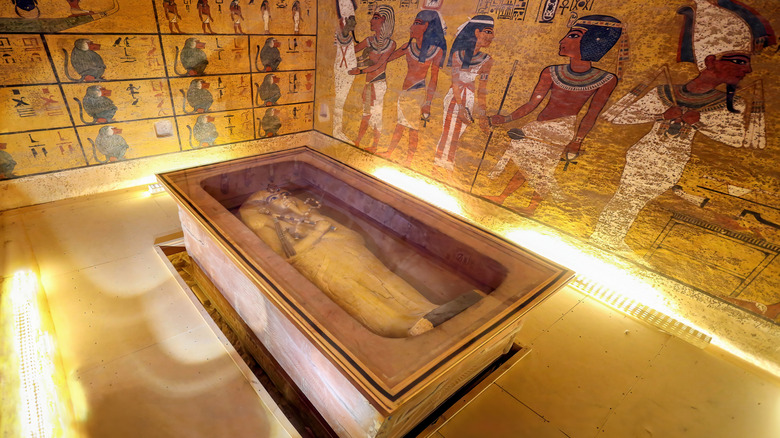The Tragic Facts About King Tut's Inbred Bloodline
Oh, royals. What with their unearned and/or undeserved wealth, endless family drama, disapproval of commoners, and servants who help them get dressed in the morning. Okay, fine. All (true-ish) stereotypes aside, life isn't always a gala of glamour for rulers of this or that nation, kingdom, empire, etc. — never has been. You know that King Tut guy? He had a slew of health problems. He was frail, sick, malarial, had a club foot due to the necrotic death of bone tissue, needed a cane to walk, and bonus: he married his sister like his parents before him. Other theories say, he was the byproduct of three generations of first-cousin interbreeding. Also, his two daughters were stillborn. Also, he was dead by 19.
What a mess, right? Never complain about how you inherited that big nose from your mom or something. At least your mom didn't marry her brother — we assume. Fourteenth-century BCE Egyptian Pharaoh and "boy king," Tutankhamun, wasn't so lucky. This was the finding of a 2010 genetic study led by famed Egyptologist Zahi Hawass and published by the Journal of the American Medical Association (JAMA) in 2010, per Live Science. The highly technical study revealed that King Tut's father was the son of the previous Pharaoh, Akhenaten (no problem there) and one of Akhenaten's sisters (big problem).
At the same time, Egyptologist Marc Gabolde said that he thought Tut's mother was Akhenaten's cousin, Nefertiti (still a problem). If so, then King Tut's genetics would have needed three generations of first-cousin inbreeding to get to the point where they were. Either way we cut it, Tut was inbred and suffered for it.
Inbreeding in ancient Egyptian dynasties
With all of the physical deformities and health problems caused by incest, you'd figure that ancient rulers would have stopped getting busy with family members. But no. As a way to maintain succession, purity, and power of bloodlines, etc., Egyptian royalty did as many rulers have done. We're talking marriage between siblings, marriage between parents and children, and marriage between cousins. Even by the time we reach the European Habsburg dynasty and the famed "Habsburg jaw," only two out of 11 marriages from 1516 to 1700 C.E. weren't between family members. Incest eventually resulted in the death of that family line with Charles II.
In ancient Egypt, however, the problem of incest would have been especially pronounced. This is because pharaohs weren't considered mere humans. They were links to the gods and formed a bridge between the earthly realm and the divine. When coronated, it was believed that pharaohs became incarnations of Horus. He was the falcon-headed god who performed numerous balancing functions in the Egyptian pantheon, like his eyes representing the morning and evening stars.
As time went on, pharaohs became more and more elevated to godly status, especially by the New Kingdom period (1539 to 1077 B.C.E.) This is exactly when King Tut lived, from 1344 to 1327 B.C.E. So how could he, his parents, or any other member of Egyptian royalty, be expected to produce offspring with mere humans? This is why he was inbred, his parents were inbred, and so were children.
Tut's inbred children
The Metropolitan Museum of Art describes the scene when archaeologists stepped into King Tut's tomb in 1922, a four-chambered tomb full of gold and alabaster objects, furniture and chariots, jewelry, and of course, the mummified boy king. It also contained a small, plain wooden box that contained two tiny coffins containing the remains of Tut's two stillborn daughters. They were also the inbred offspring of Tut and his sister, Ankhesenamun.
Strictly speaking, Promega Connections tells us that researchers weren't sure if Tut's two stillborn daughters died of deformities due to their father's inbred bloodline. The mummies, however, were of two different sizes — the larger one speculated to be 37 weeks old and the smaller 25 weeks. The American Journal of Roentgenology, however, theorizes that the girls were twins and the difference in size was due to twin-twin transfusion syndrome, in which twin fetuses share a placenta and there is unequal transmission of nutrients, causing problems for each. Both of their skulls displayed "extensive" fractures, and the larger one had multiple fractures across her spine, arms, feet, and shoulders sustained after death. While this is disturbing to think about, and lots of questions remain, we at least know that babies born of incestuous, "cosanguinous" unions — from the same blood — have a higher chance of being born prematurely.
The truly tragic part of this entire tale is that someone like King Tut really had no choice in any matter at all. He certainly didn't elect to be inbred or to produce inbred children. He was only 9 years old when he was crowned pharaoh — another choice that wasn't him. He then died at 19 having fathered two stillborn children. This meant that Tut's inbred line died with him. The next pharaoh, Ay, was completely unrelated by blood.


